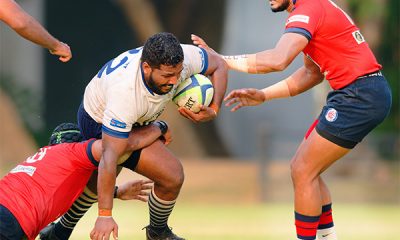Sports
Lost rugby crowds and a SLR President who plants trees!
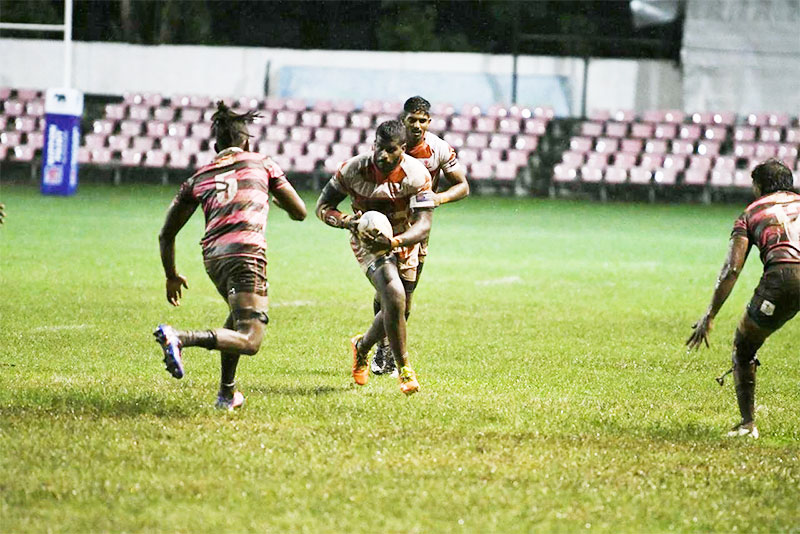
by A Special Sports Correspondent
Rugby in Sri Lanka, despite producing some well-contested games, is struggling to attract crowds; especially at Havelock Park where games are played under floodlights.
Rugby can be easily rated as the second most popular sport after cricket in this little island. The rugby fraternity is now seeing four generations or more of rugby followers visiting stadiums to catch the action. Many years ago the crowds simply flocked to these grounds when the game was played by players in the likes of Michael Jayasekera, Hisham Abdeen, Chaminda Rupasinghe, Anjelo Wickremaratne, Marco de Silva, Kolitha Gunatilake, Priyantha Ekanayake, Imthie Marikar, Roger Rodrigo, Saman Kotalawela, Nizam Jamaldeen, Chandrishan Perera, Palitha Siriwardene, Lakshman Ekanayake, Norman Silva, Amjad Buksh, Sudath Sampath, Shamly Nawaz, Sithara Fernando, Len Silva, H.K. Sisira, Asanga Senewiratne, P.G Gunawardene, Nalin de Silva, Chandana Deepthi, Tony Wimalasuriya, Simon Hunter, Apisi Nagata, Tulagaese Tawita (Laga), Kiti Ratudradra, Bati Ponaia, Sajith Mallikarachchi, Fazil Marija, Radeeka Hettiarachchi, Sanjeewa Jayasinghe and Asoka Jayasena to name a few. These players were looked upon as celebrities or demi gods. (This writer’s apologies go out to readers for him not having the good fortune to be born earlier than the Abdeen era to witness the Sri Lankan greats who were at rugby before the above mentioned players; hence the omission of their names from this list). Rain or sunshine crowds were present at venues to watch their heroes at a time when playing competitive rugby was a lot simpler and players could take a ‘sip’ from the best things that life offered back then.
A positive factor about present rugby is that games are played faster, the players are stronger and can stretch the playing phases to more than ‘two’; which is how the game is played in other rugby playing nations which are rated above Sri Lanka. This writer remembers Milinda Jayasinghe (Former CH&FC scrum half) who got to play in New Zealand’s second division league rugby set-up. The moment the coach saw the player at his first practice session at the club he was welcomed with a warning “Welcome to the club, but the two hits ball out system adopted in Sri Lanka won’t work here mate. We go twenty-thirty hits before someone takes the ball over the try line and get ready for that”. Many years after Jayasinghe hung up his boots Sri Lanka rugby has come somewhere at least in terms of domestic rugby. There is plenty in rugby to ‘munch on’ and enough good players to entertain crowds. It certainly is not a colourless sport like present day badminton, table tennis, kabaddi, hockey and football. This colour is given to the sport when it has players of repute who maintain standards. In this aspect Kandy SC tops the list. When the Nittawela players travel to Colombo or venues in the Western Province we see the Kandy crowds following them. When loyalty at rugby is build it comes to stay (we are talking about spectators at least in this paragraph).
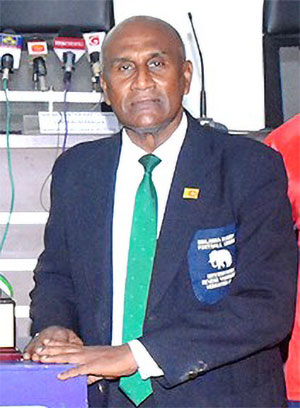
Sri Lanka Rugby’s President elect Nalin de
Silva. (Pic by Kamal Wanniarachchi)
You need the players, crowds and referees who are capable of handling knowledgeable players, who have decided to move to a semi-professional or a professional level of rugby after completing successful seasons with their schools. The referees at present look very confident on the field, but there have been occasions when they were wanting in tense situations in play during the school rugby season which concluded for the year 2023. These referees need time to settle down and mature and if this writer’s memory serves him right most of these referees (except Suranga Arunashantha) have not played any top level rugby like the referees of yonder. Many seasons ago we had referees who were also prominent national or domestic rugby players. A few good examples of referees who fell into this category were Denzil Kobbekaduwa, Daya Jayasundara, Nizam Jamaldeen, Aruna Jayasekara, Roshan Deen, Nimal Lewke and J.P.U.M. Jayawardene (Japana). Then we had an era where referees were officiating for the mere love of the game in an amateur set-up which gave no recognition or worthwhile remuneration to them. All that changed after the Sri Lanka Society of Rugby Football Referees started sending their members for training and charging professional fees for sending referees to officiating in matches.
Coming back to Havelocks Sports Club, this is a venue which has produced some unforgettable memories for rugby fans. Then matches were not played under lights, but the power of rugby that was produced was simply good enough to promise a full capacity crowd on any day of the week. Sri Lanka Rugby’s President elect Nalin de Silva (of Air Force fame) is all out to play matches at the Park Club under lights. He told media representatives at a rugby launch held for the 2023/24 league rugby tournament that he believed that crowds would come if matches are played in such an environment even on a Friday. We have a rugby president who is very technical when he talks and underscores the importance of planting trees at rugby venues; especially at Havelock Park. This is because the floodlights produce carbon emission and only trees in large numbers can erase the negative factor associated with playing games under such conditions. The rugby president has also stressed the importance of planting trees going hand in hand with playing the sport because he believes that the former can reverse the effects of climate change. De Silva has stressed that the advancing of the commencing time for domestic club rugby matches from 4.30 pm to 3.30 pm was because the light fades faster these days due to the ill effects on the environment.
Havelocks SC is a top runner in the tournament and the floodlight facility it provides for games together with the atmosphere at the ‘park’ are really what any sports promoter would ask for if he is to initiate a campaign to bring back the lost crowds. Rugby badly needs those large crowds, generous sponsors and venues that have huge trees; the latter the more the merrier!
Sports
England face Australia in the battle of champions
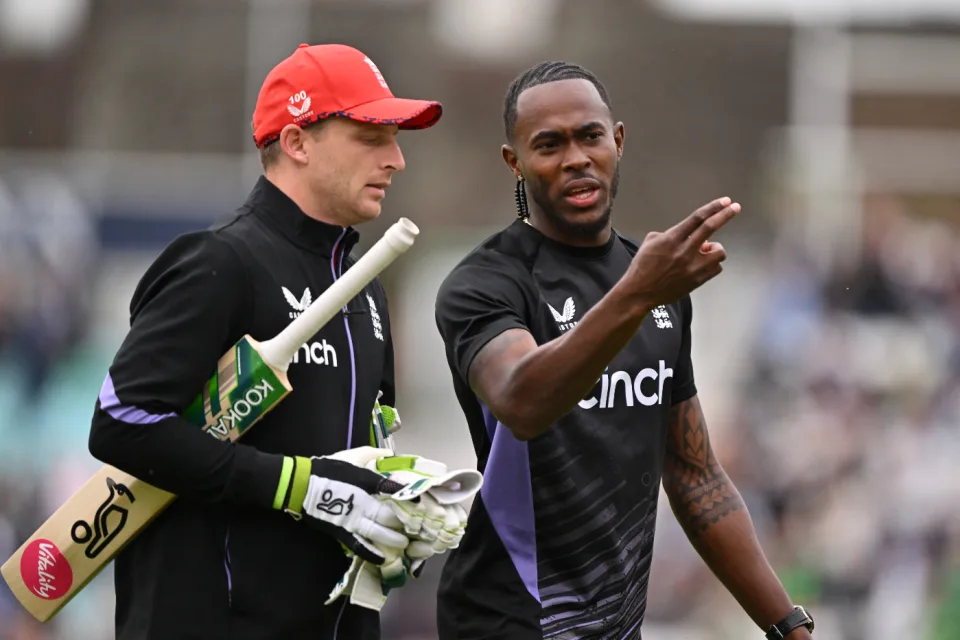
The first truly heavyweight clash of this expanded T20 World Cup format comes freighted with both history and subplots. A rematch of the 2010 World T20 final at Kensington Oval, the match pits Jos Buttler’s defending champions – who are aiming to become the first team to retain the trophy – against the Australian winning machine, victors at the 2021 edition and current world title-holders in Test and ODI cricket. And that’s before you throw in the Ashes for afters.
Already there is added pressure on England, after the rain in Bridgetown led to a share of the points in their opener against Scotland (and that having conceded 90 runs from 10 overs without taking a wicket in a tepid bowling display). Lose to their oldest rivals and it will leave their Super 8 prospects open to being waylaid by the perils of net run-rate calculations, or worse.
The Scotland match was the third abandonment in five suffered by England, after a rain-affected home series against Pakistan, which has clearly hampered their readiness for this campaign after almost six months without playing T20 together. It does not take much for a side to click in this format – and England looked in decent shape when they did get on the field against Pakistan – but Buttler will be anxious for things to go their way on Saturday, if only to avoid further questions referencing the team’s disastrous ODI World Cup defence last year.
Australia, under the laidback leadership of Mitchell Marsh would love nothing more than to add to the English sense of jeopardy – having helped bundle them out of the tournament in India on the way to taking the crown. Their head to head record is less impressive in T20 however, with England having won six of the last seven completed encounters, as well as that 2010 final.
Despite a wobble with the bat, Australia avoided mishap against Oman earlier in the week, the experience of David Warner and Marcus Stoinis shining through in difficult batting conditions. Surfaces in the Caribbean – not to mention those games staged in the USA – have already had teams scratching their heads; rather than the “slug-fest” England had prepared for, following a high-scoring tour of the Caribbean in December, it looks as if boxing smart may be the way to go.
Speaking of Warner, this could be the last time he faces up against England in national colours – and another match-winning contribution would likely reduce the chances of them meeting again in the knockouts. On the other side of the card is Jofra Archer, fresh from an emotional maiden outing at Kensington Oval and ready to take on Australia for the first time in any format since 2020. Can Mark Wood fire up England’s campaign, as he did during last summer’s Ashes? Will Pat Cummins be back to harass the old enemy once again? Seconds out, it’s almost time to rumble.
Cummins is set to return after being rested for the Oman game, which saw Mitchell Starc leave the field with cramp. Starc is understood to be fine and could keep his place – which would likely see Nathan Ellis miss out. Marsh is still not fit to bowl, with Australia likely to continue with the allrounder combination of Stoinis and Maxwell to give them cover.
Australia (probable XI): David Warner, Travis Head, Mitchell Marsh (capt), Glenn Maxwell, Marcus Stoinis, Josh Inglis (wk), Tim David, Pat Cummins, Nathan Ellis/Mitchell Starc, Adam Zampa, Josh Hazlewood
The one change England may consider is Reece Topley coming in for Wood, with the expectation that there will be some rotation among the seamers through the course of the tournament.
England (probable XI): Phil Salt, Jos Buttler (capt & wk), Will Jacks, Jonny Bairstow, Harry Brook, Liam Livingstone, Moeen Ali, Chris Jordan, Jofra Archer, Adil Rashid, Reece Topley/Mark Wood
[Cricinfo]
Sports
South Africa up against their bogey team in batter-unfriendly New York
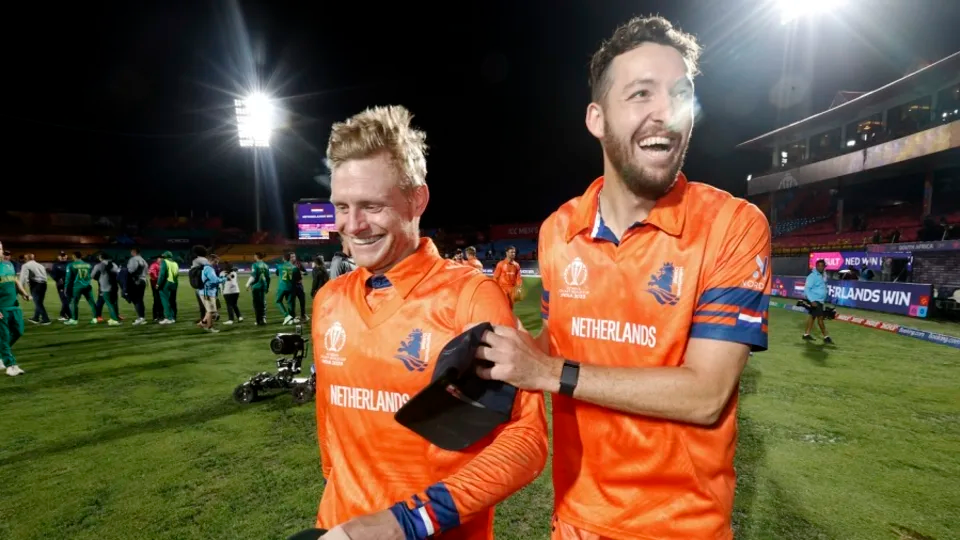
Once is coincidence, twice is a clue, and three times is proof.
To paraphrase Agatha Christie, that is the narrative around South Africa’s meeting with Netherlands at this T20 World Cup.
The Dutch beat South Africa at the 2022 tournament and ended their semi-final hopes in a match where South Africa appeared to be sleep walking, and then beat them again at the 2023 ODI World Cup, where they exposed South Africa’s vulnerability in the chase. If they to do the treble, not only will Netherlands take the lead in Group D, but they will offer conclusive evidence of the threat they pose to Full Members, especially South Africa.
Of course, it will take some doing after South Africa’s opening performance against Sri Lanka, where they reduced their opposition to their lowest T20I total and chased it down in fairly straightforward fashion thanks to the most stable middle-order of their white-ball era. In Aiden Markram, Tristan Stubbs, Heinrich Klaasen and David Miller, South Africa have bankers and big-hitters and, for this match, they also have the advantage of experience. They’ve already played at Eisenhower Park, and have first-hand knowledge that run-scoring doesn’t come easily;Klassen said they are prepared to use their “cricket brains” and play “smarter cricket”.
But the conditions could be good news for Netherlands, who are not naturally a line-up of big hitters and build their innings on a foundation of turning ones into twos. In other words, they tend to take a slightly more conservative approach to batting, which may work well here, but they’ll be wary of the uneven bounce of the surface and will have to come up with plans to counterattack especially against South Africa’s seamers. Their own bowlers were exemplary in Dallas and will look to build on that performance against a line-up that will likely be more proactive than Nepal’s, but who they have managed to keep quiet not once, but twice in the past. Third time’s the charm, they say.
Anrich Nortje’s stunning return to form against Sri Lanka means South Africa may not have to tinker with the bowling combination, and Gerald Coetzee and Tabraiz Shamsi may have to wait their turns to get a game. The batting line-up should be unchanged, with no space for Ryan Rickelton yet.
South Africa: Quinton de Kock (wk), Reeza Hendricks, Aiden Markam, Tristan Stubbs, Heinrich Klaasen (wk), David Miller, Marco Jansen, Keshav Maharaj, Kagiso Rabada, Ottneil Baartman, Anrich Nortje
Conditions in New York may tempt Netherlands to include an extra seamer and they have Kyle Klein in their squad. But it could come at the expense of a shortened batting line-up and they may not want to risk that.
Netherlands: Michael Levitt, Max O’Dowd, Vikramjit Singh, Sybrand Engelbrecht, Scott Edwards (capt, wk), Bas de Leede, Teja Nidamanuru, Logan van Beek, Tim Pringle, Paul van Meekeren, Vivian Kingma
[Cricinfo]
Latest News
Mustafizur, Rishad, Hridoy dazzle in Bangladesh’s tight two-wicket win over Sri Lanka
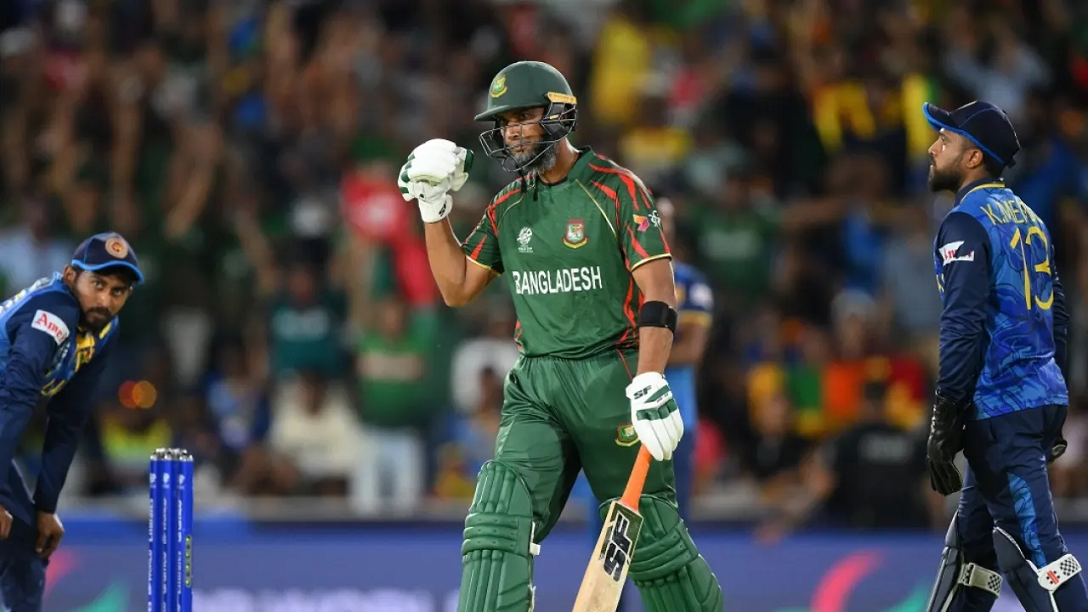
Nuwan Thushara’s last over brought Sri Lanka screaming back into the match,as he first bowled Rishad Hossain, and then nailed Taskin Ahmed in front of the stumps with a pinpoint swinging yorker. This left Bangladesh eight wickets down, with 12 runs still to get.
However, the experienced Mahmudullah was at the crease for Bangladesh, and despite some further nervy moments, pushed Bangladesh across the line off the last ball of the 19th over.
But this was a match chiefly decided by Bangladesh’s own outstanding bowling. Mustafizur Rahman was the best among them, using shorter lengths and his cutters efficiently, to claim figures of 3 for 17. Rishad Hossain’s three-for through the middle overs also kept Sri Lanka quiet.
Mustafizur was instrumental in Sri Lanka’s downward spiral through the middle overs, which culminated in a crash-and-burn end. Ultimately, their inability to find boundaries, or even rotate strike against good Bangladesh bowling resulted in their downfall. A score of 125 for 9 always seemed poor on a decent pitch, even if their bowlers made a match of it in the end.
Brief scores:
Bangladesh 125 for 8 in 19 overs (Towhid Hridoy 40, Litton Das 36; Dhanajaya de Silva 1-11, Nuwan Thushara 4-18, Wanidu Hasaranga 2-32, Matheesha Pathirana 1-27) beat Sri Lanka124 for 9 in 20 overs (Pathum Nissanka 47, Dhananjaya de Silva 21; Tanzim Hasan Sakib 1-24, Taskin Ahmed 2-25, Mustafizur Rahman 3-17, Rishad Hossain 3-22) by two wickets
[Cricinfo]




